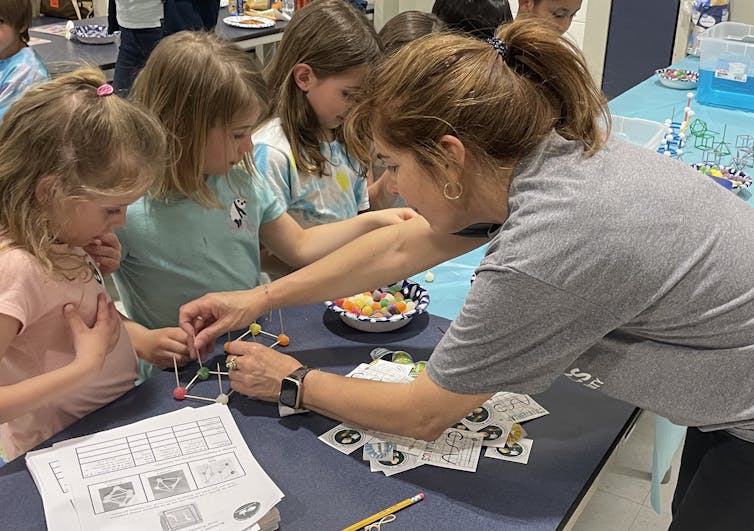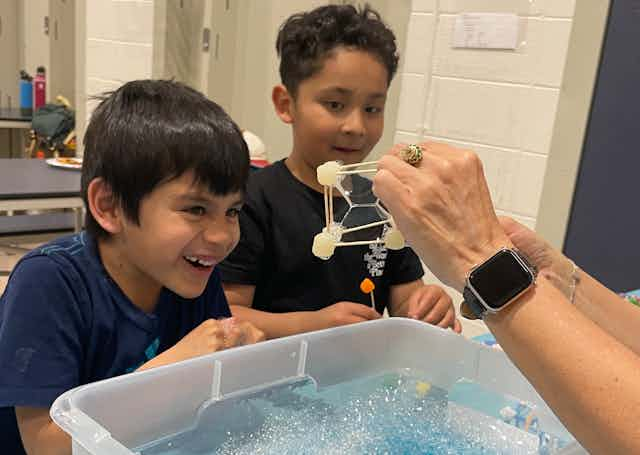
Curious Kids is a series for children of all ages. If you have a question you’d like an expert to answer, send it to curiouskidsus@theconversation.com.
Will I ever need math besides for school or work? – Hadassah G., age 9, New Jersey
It can be easy to think that you need math only to do your algebra or geometry homework or if you have a job as an engineer. But, in fact, math pops up everywhere – even in the soap bubbles in your kitchen sink.
While washing dishes when I was 13, I noticed that the soap bubbles formed tiny 3D polygons, packed together like a honeycomb, but not all of these shapes were perfectly round. Why did some of the bubbles look like hexagons? Why were others shaped like squares full of air? Why didn’t I see any star-shaped bubbles, or bubbles with spikes?

When I learned that math could help answer these questions, I thought that was so cool! Now, as a professor of mathematics who studies how people learn math through play, I understand why bubbles are naturally lazy. I even studied the math behind the reason I saw only some shapes in soapy dishwater.
Besides helping explain the behavior of bubbles and other curiosities of nature, math is likely part of many of your everyday activities, along with the technology you enjoy and even the inner workings of your brain. Doing math isn’t just about computing, memorizing, solving an equation or doing word problems by yourself. It’s really about creative problem-solving and logical thinking with other people.
Math in everyday life
Many topics you learn in elementary school – like fractions, percentages and measurements – are useful in everyday life.
For example, if you want to build a fence around your house, paint your walls a new color or with a design, or sew yourself a new outfit or quilt, all of those activities require knowledge about measurement and scaling. More complicated construction projects, such as building a treehouse, require lots of mathematical problem-solving skills.
Once you’ve laid out the plans for one of these projects, you need to buy all the materials. Percentages – which are special kinds of fractions – are especially important to understand when managing money. Understanding percentages can help you budget your money and increase your net worth.
Beyond budgeting, you might find yourself using percentages when cooking a double batch of brownies, determining how much medicine to take when you’re sick or understanding the weather forecast.
Your favorite technology needs math
Math is an essential tool that animators use to make movies.
Studios like Pixar rely on ideas from geometry to bring characters like Ember from “Elemental” to life. With an understanding of geometric transformations like reflections, rotations and translations, you can use your computer to make your own animations.
Coordinate systems, which are fundamental to geometry, show up in video games like Minecraft. The 2D Minecraft world uses a 2D coordinate system – with an x-axis and a y-axis – where you can move north, south, east or west. In the 3D Minecraft world, there’s also a z-axis, allowing you to move up and down. Middle and high school teachers can even use Minecraft to help students learn math concepts.
Many high-paying jobs use math, especially probability – again, fractions. Understanding probability helps doctors identify how effective medical treatments are, informs coaches about ways their teams can improve and aids cryptographers in keeping private information – like your email password or ATM PIN – secret. Cryptography combines probability with number theory to create secret codes that are difficult to crack.
Math helps your brain
Math can have a big impact on your internal life, too. You can use math activities to train your brain the same way you would train your body for a sport. Doing math helps your brain become flexible so you can better handle new tasks and ideas of all kinds.
Even doing things that don’t look like your math homework, such as crossword puzzles, word searches and board games like Set and Blokus, are deeply mathematical activities that help your brain get stronger. This kind of mental training helps the brain pay attention and solve problems and improves memory. A strong working memory supports brain functions that lower the risk of Alzheimer’s disease and dementia.
Having a stronger, more flexible brain also aids quantitative literacy, which can help you make sense of graphs that appear in the media, reflect critically about news and understand health and financial information.
Math can even help you outsmart artificial intelligence. With the rise of AI, it’s important to be able to think creatively, reason logically and make connections between concepts – whether mathematical or not. Puzzling through a difficult math problem nurtures these skills, even if you don’t get the right answer right away.

It’s important to remember that doing math doesn’t require you to be fast or to get the correct answer right away. In fact, you can learn a lot by getting the wrong answer. Working with other people can also help you to make sure you really understand the problem and builds communication and teamwork skills.
Math is so much more than memorizing times tables and filling out homework problem sets. So next time you kick back to watch your favorite animated movie, or start saving up for a fancy new tech gadget, hopefully you’ll appreciate how math is woven into so many parts of life.
Hello, curious kids! Do you have a question you’d like an expert to answer? Ask an adult to send your question to CuriousKidsUS@theconversation.com. Please tell us your name, age and the city where you live.
And since curiosity has no age limit – adults, let us know what you’re wondering, too. We won’t be able to answer every question, but we will do our best.


